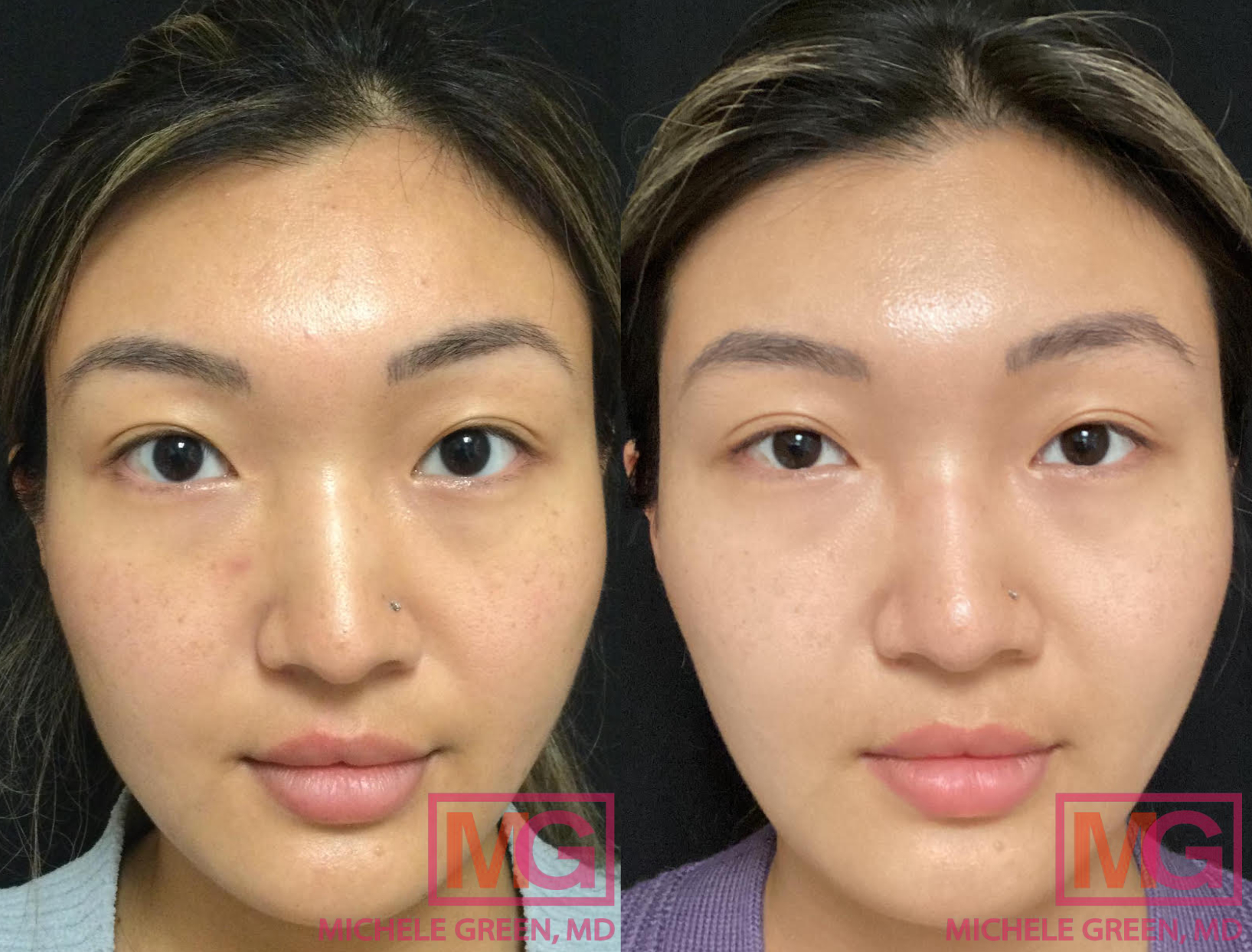Best Botox Injections in New York
Botox is the most popular cosmetic procedure worldwide because of its ability to provide facial rejuvenation. Fine lines and wrinkles can develop on the face due to repeated expressions, making us appear older than we really are. If you notice these signs or want to prevent them, Botox could be the perfect non-invasive cosmetic option. With simple yet effective Botox injections, patients can achieve smooth, glowing, and wrinkle-free skin with minimal downtime and side effects. Dr. Green was among the first physicians in New York to offer cosmetic Botox injections and is known for providing the “best Botox in New York City.”
Since the FDA approved Botox for cosmetic use in 2002, its popularity has increased significantly. Botox, also known as botulinum toxin, is a neuromodulator that essentially ‘freezes’ targeted facial muscles by blocking nerve signals that control expression. This process effectively reduces the muscle’s ability to contract fully. Botox is currently FDA-approved to treat forehead lines, lines between the eyes, and crow’s feet caused by raising eyebrows, frowning, squinting, and smiling; however, Botox can also be used for other cosmetic concerns, such as a square jaw, vertical neck bands, a thin upper lip, and certain medical conditions, including cervical dystonia and migraines. If you’re interested in facial rejuvenation and want safe, effective, and painless Botox injections, consult with Dr. Green today.
Dr. Michele Green is an Allergan platinum injector of Botox in NYC and a leader in cosmetic injectables and non-invasive facial treatments. Dr. Green is consistently recognized as one of NYC’s top dermatologists by Castle Connolly, Super Doctors, The New Yorker, and The New York Times for her expertise and dedication to her patients. With over 25 years of experience with Botox injections and other non-invasive procedures, Dr. Green follows a “less is more” philosophy to achieve natural-looking yet stunning results. Dr. Green’s unique Botox technique will leave you looking and feeling like the best version of yourself.
What is Botox?
Botox Cosmetic is a non-invasive injectable treatment that relaxes muscles at the injection site. It was originally developed by ophthalmologists to address poor eye muscle control and eye spasms. Once its impressive cosmetic benefits were recognized, Botox became widely popular for delivering natural-looking results with minimal downtime. In 2002, the Food and Drug Administration (FDA) approved the use of Botox for reducing fine lines between the eyebrows. Today, it is FDA-approved for smoothing fine lines on the forehead and around the eyes. It is also commonly used for other aesthetic concerns, such as masseter hypertrophy, vertical neck bands, a Botox lip flip, and a downturned smile. Board-certified dermatologist Dr. Michele Green is a skilled injector, providing expert care, precision, and artistry to ensure optimal Botox results at her discreet dermatology practice on the Upper East Side, NYC.
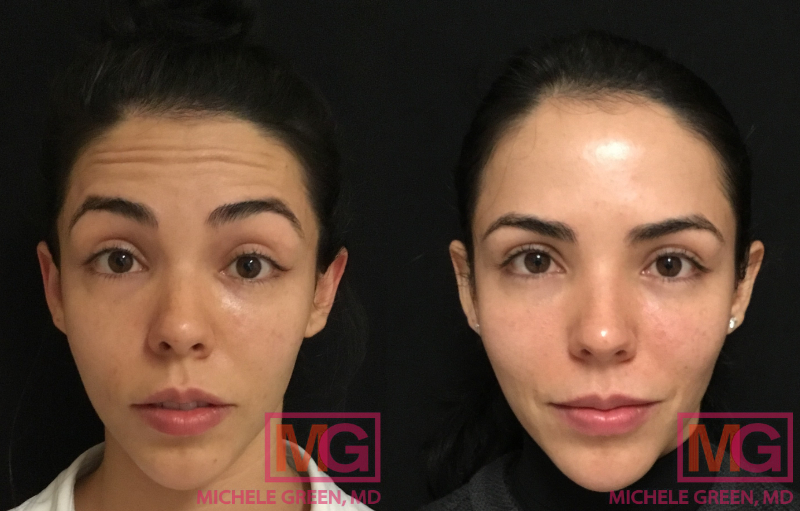
Botox 3 weeks before and after
What is Botox made of?
Botox contains the active ingredient botulinum toxin type A (onabotulinumtoxinA) and inactive ingredients, such as human albumin and sodium chloride. Botulinum toxin type A is a protein derived and purified from the bacterium Clostridium botulinum. The human albumin and sodium chloride help stabilize the toxin, protecting it during manufacturing, storage, and injection.
How does botulinum toxin work?
Botulinum toxin is a neuromodulator that targets the neuromuscular junction to temporarily block nerve signals. Once injected, the muscles become “frozen” and are unable to contract normally. By reducing muscle contractions, the skin doesn’t develop the associated dynamic wrinkles, leading to smooth, more youthful-looking skin. Typically, results from Botox injections become visible after two weeks, and the effects last for three to four months.
What are the most common cosmetic areas injected with Botox?
The facial areas for which Botox has been approved to treat have expanded over the years. Initially, Botox was only approved for the glabella lines or furrows between the eyebrows. However, the indications for Botox have grown to include many other cosmetic treatment areas, all of which Dr. Green performs in her private NYC dermatology office:
- Forehead lines — These horizontal lines on the forehead appear when raising the eyebrows. Botox can help reduce these lines and smooth the skin on the forehead.
- Glabellar lines — These vertical lines between the eyebrows, also called frown lines or 11’s, result from furrowing the brow. Glabellar lines are often very deep and can make patients appear as if they are always frowning or upset.
- Crow’s feet — Crow’s feet refer to the fine lines that appear around the eyes. These lines are often caused by repeated smiling or squinting.
- Brow lift — During a Botox brow lift, Botox is injected into the muscles between the eyebrows that form furrows and at the tail of the brow to help lift the brows and open up the eye area.
- Masseter muscle — The masseter muscles are located on each side of the jaw. When overused, these muscles can become enlarged, leading to a square jaw appearance and TMJ problems such as grinding, clenching, and tension.
- Platysmal neck bands — Platysmal bands are lines or cords that run vertically along the neck. The “Nefertiti Lift” is a popular cosmetic procedure that involves injecting Botox into the platysma bands and along the jawline to reduce fine lines and wrinkles, resulting in a lifted and more youthful look in the neck.
- Upper lip — Botox injections are ideal for patients seeking a subtle lift in the upper lip. Botox can be injected into specific lip muscles to “flip the lip” and create the appearance of a fuller pout.
- Wrinkling in the chin —Pau d’orange of the chin — Some individuals develop texture and dimpling on the chin, commonly called pau d’orange. Botox injections into the mentalis muscle effectively reduce muscle contractions, thereby lessening the appearance of chin dimples and wrinkles.
- Corners of the mouth — Botox can be injected into the depressor anguli oris (DAO) muscle, which pulls the corners of the mouth downward, to improve the appearance of a drooping smile, enhance facial symmetry, and reduce fine lines and wrinkles around the mouth.
- Gummy smiles — A gummy smile occurs when too much gum tissue shows when you smile. Botox can be injected into the elevator muscles of the upper lip to reduce its upward movement during smiling.
- Bunny lines on the nose — Bunny lines are wrinkles on the nose that appear when the nose is scrunched during expressions like laughing, smiling, and squinting.
Botox for Temporomandibular joint (TMJ) pain
Botox injections into the masseter muscle are highly effective for managing TMJ symptoms. Characterized by tenderness along the jawline, aches around the ear, jaw joint pain, chronic migraines, and jaw dysfunction that can lead to difficulty chewing and opening or closing the mouth, TMJ can be a debilitating condition. Botox works by “freezing” overactive jaw muscles. It typically takes 1-2 weeks for the full effects to become noticeable. Results usually last for four to six months, and many patients opt for regular maintenance sessions to sustain the benefits.
Botox for Axillary Hyperhidrosis
Botox is commonly used to treat hyperhidrosis, or excessive sweating. In 2004, the FDA approved Botulinum toxin (Botox) for treating excessive underarm sweating, and it remains a popular procedure with few side effects and minimal downtime. When a board-certified dermatologist like Dr. Michele Green injects Botox into the underarms, the overactive nerves are “frozen,’ which prevents them from signaling sweat glands and helps control sweating. Studies indicate that Botox reduces underarm sweat by 82-87%, with visible results in as little as two weeks. This treatment can offer significant relief for hyperhidrosis, especially for patients who haven’t had success with other topical or in-office options.
Do healthcare providers use Botox for other medical conditions?
Yes! One of the most common medical uses for Botox is to treat severe migraines. Neurologists often administer Botox injections to help migraine sufferers decrease their symptoms. Botox injections are well known for effectively treating chronic migraines without relying on medications that cause side effects. Botox is absorbed by the pain receptors in the forehead, scalp, neck, and shoulder muscles, relaxing the muscles and relieving chronic migraines. Other medical conditions treated with Botox include cervical dystonia (a neurological disorder affecting the neck muscles), overactive bladder, blepharospasm (eyelid spasm), strabismus (a condition where the eyes can’t look in the same direction), upper limb spasticity, and muscle spasms.
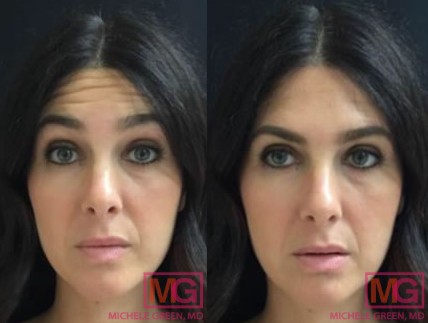
What is the procedure for having Botox injected?
Before receiving Botox injections, you will first have a consultation with Dr. Green at her private NYC dermatology office. During this appointment, you can discuss your specific concerns and your ideal aesthetic results. Medical photography will be taken to help determine the best cosmetic treatment for you and to monitor your progress. Dr. Green will take a detailed medical history, review any previous cosmetic procedures, and evaluate your unique facial anatomy. Your Botox injections may be performed on the same day as your initial consultation or scheduled for a later date, based on your personal preference.
To prepare for your Botox treatment, it is recommended to avoid blood-thinning medications such as Aspirin, Aleve, Motrin, multivitamins, and fish oil for two weeks prior to the procedure to reduce the risk of bruising at the injection sites. When you arrive at Dr. Green’s office, the treatment area will be thoroughly cleaned and prepared. Dr. Green will mark the injection sites and perform the injections with a small needle. An ice pack will be applied immediately afterward to help minimize swelling. She will give you detailed aftercare instructions. Many patients return in two weeks for a follow-up to evaluate the results and discuss if additional Botox is necessary.
What is the downtime after botulinum toxin injections?
Botox injections are quick and simple, with little downtime. Immediately after injections, patients may notice some swelling at the treatment site, which typically subsides within an hour. Applying an ice pack immediately can help reduce swelling. The main aftercare tip is to stay upright for four hours, avoiding bending over or lying down, so the Botox can settle properly. Strenuous activity, hot tubs, and saunas should be avoided for 24 hours to prevent swelling. Patients should also avoid putting pressure on the treated area for three days. Additionally, they should avoid blood thinners and blood-thinning vitamins for a week to reduce the risk of bruising. Those prone to bruising may take Arnika for three to four days to help prevent bruising and speed up the healing of any bruises that do develop.
What are the side effects of Botox?
Botox injections are generally very safe, with few side effects after treatment. Common ones include mild redness, swelling, and bruising. Some patients may experience mild headaches after receiving Botox in the face, although this is not a common side effect.
Other side effects of Botox that can occur include:
- Flu-like symptoms
- Dry eyes or excessive tearing
- Drooping eyelid or ptosis
Immediate allergic reaction side effects that require immediate medical help include:
- Itching
- Rash
- Red itchy welts
- Wheezing or Asthma symptoms
- Dizziness
Rare side effects of botulinum toxin products may include:
- Muscle weakness
- Trouble breathing, talking, or dysphagia (trouble swallowing)
- Vision problems (double vision or blurred vision)
- Urinary incontinence (loss of bladder control)
- Hoarse voice
- Neck pain
- Paralysis
- Antibodies to Botox – Some patients receiving injections of Botulinum toxin type A develop antibodies to the toxin, making subsequent treatments ineffective.
If you develop any of these serious side effects following Botox, further injections of Botox should be discontinued, and you should contact your treating physician. Adverse side effects to Botox injections can be reported to www.fda.gov/medwatch.
When does the effect of Botox “kick in”?
Patients should not expect their Botox to “kick in” immediately. Botox injections take a few days to “kick in,” and the full effect is evident after two weeks.
How long does it take for Botox to settle?
It can take up to two weeks for Botox to take effect, after which patients can expect to see and feel the full benefits of the treatment. Dr. Green recommends that all her Botox patients return to her two weeks after their cosmetic injections to ensure the effectiveness of their Botox treatments and to achieve the best results.
How long does Botox last?
Botox injections usually last for three to four months. Some patients notice that with regular maintenance sessions, their Botox effects can last up to six months.
Is Botox safe?
Yes! Botox is an FDA-approved cosmetic injectable treatment, which means many clinical trials and studies have demonstrated its safety and effectiveness. Few side effects are associated with Botox, such as mild redness, swelling, and bruising, which typically subside on their own within two weeks of treatment. Botox injections can provide safe, stunning, and natural-looking results. It’s crucial to have your injections performed by a board-certified dermatologist, such as Dr. Green, as an inexperienced provider could cause unwanted cosmetic results or side effects. Dr. Green was among the first in NYC to offer Botox to her patients and ensures that your Botox treatments are both safe and effective.
Does Botox work?
Definitely! Botox is one of the most popular non-invasive cosmetic procedures worldwide and is considered the gold standard for reducing dynamic fine lines. Botox is an injectable neuromodulator that smooths and prevents wrinkles by blocking nerve signals to the facial muscles responsible for expressions. It reduces fine lines and creates a more youthful look by limiting muscle movement. A clinical study involving an experimental group and a placebo group demonstrated that Botox effectively and temporarily reduced frown lines, resulting in a younger appearance. Patients who received Botox were generally satisfied with the results and reported a smoother complexion. Botox is well-known for its ability to smooth out dynamic fine lines and wrinkles, resulting in a refreshed and revitalized appearance. When you consult with Dr. Green, she will develop a personalized Botox treatment plan to help you achieve clear, smooth, and radiant skin that lasts.

Frequently Asked Questions (FAQs) about Botox injections
Where does Botox come from?
Botox is derived from botulinum toxin, a neurotoxin protein produced by the bacterium Clostridium botulinum. Botox Cosmetic is manufactured by Allergan Aesthetics, a pharmaceutical and medical aesthetic company owned by AbbVie.
When was Botox invented?
Botulinum toxin was first discovered in the late 1800s when scientists studied a botulism outbreak. Its use for cosmetic purposes began to gain popularity in the late 1990s, when researchers discovered that precise application of the drug could temporarily block facial muscle movements and reduce fine lines and wrinkles. Today, Botox is among the most popular cosmetic treatments worldwide, valued for its safety, effectiveness, and ability to rejuvenate the face with minimal downtime and side effects.
Is Botox a neurotoxin?
Yes, Botox is a neurotoxin that affects nerve signaling at the neuromuscular junction. When injected into targeted muscles, Botox temporarily blocks muscle contractions, preventing the muscles from forming fine lines and wrinkles on the face.
Are all neuromodulators the same?
No. Botox is a neuromodulator made of onabotulinumtoxinA that essentially ‘freezes’ certain facial muscles involved in expression. Other neuromodulators used for cosmetic purposes include Dysport (abobotulinumtoxinA), Xeomin (incobotulinumtoxinA), Jeuveau (prabotulinumtoxinA), Myobloc (rimabotulinumtoxinB), and Daxxify (daxibotulinumtoxinA). These neuromodulators are mostly interchangeable and can be used to achieve similar cosmetic results or to treat symptoms of various medical conditions. However, the main difference lies in their formulation and the presence, absence, or type of additive proteins included. Botox contains complexing proteins attached to the botulinum toxin, while Xeomin and Dysport do not have these proteins. The differences in formulations can influence the duration and effectiveness of treatment over time in certain individuals.
What is the difference between Xeomin and Botox?
Xeomin, like Botox, is an injectable neurotoxin used to treat fine lines and wrinkles caused by muscle movement. Botox and Xeomin can be used interchangeably. They are both derived from type A botulinum toxin, so they work similarly on the nervous system. The main difference is in their protein attachment. Unlike Botox, Xeomin does not have a complexing protein attached to the botulinum toxin, which causes Xeomin to diffuse less than Botox. While some patients may develop resistance to the added protein in Botox, they cannot develop resistance to Xeomin. Some patients produce antibodies to the complexing protein in Botox, leading their bodies to neutralize the drug more quickly, reducing its duration and effectiveness. Because Xeomin lacks these complexing proteins, resistance to it cannot develop.
Does Botox get rid of wrinkles?
Yes! Botox is the leading treatment for reducing dynamic wrinkles caused by repetitive facial movements. Botox is an injectable cosmetic known as a neuromodulator, which means it blocks nerve signals to specific facial muscles, decreasing their contractions. When Botox is injected into the muscle at the corner of the eye, it blocks nerve signals to that area, relaxing the muscle, smoothing the skin, and gradually eliminating fine lines.
Will Botox lift your eyebrows?
A Botox brow lift is a popular cosmetic procedure performed at Dr. Michele Green’s office. It is an injectable treatment that smooths forehead wrinkles and fine lines, lifts the eyebrows, and reduces upper eyelid hooding. Many prefer Botox brow lifts over surgical ones, which can sometimes result in an unnatural or “surprised” appearance. However, injecting too much Botox into the forehead can make the brow seem heavier and cause the eyebrows to droop, making the eyes look smaller. Therefore, it’s crucial to consult with an experienced, board-certified dermatologist who understands facial muscle anatomy and knows the precise injection points to achieve optimal results. Dr. Green in NYC is an Allergan platinum injector with decades of experience delivering some of the best Botox treatments in the city. If you’re interested in a Botox brow lift, schedule a consultation with Dr. Green at her boutique dermatology office in the Upper East Side of Manhattan.
Can Botox help with jowls?
No. Jowls are the result of collagen loss, which leads to sagging skin along the jawline and underneath the chin. As we age, collagen production decreases, leading to increased skin laxity, which can contribute to the development of jowls. To effectively treat jowls, Dr. Green often performs Thermage, a non-invasive skin-tightening treatment. Thermage delivers radiofrequency energy to the dermis, gently heating the inner layer of skin to stimulate new collagen production and remodel existing collagen, resulting in tighter, firmer skin. Patients typically notice results from Thermage after three to four months, with the effects lasting about 18 months. Since there is no downtime with Thermage, it is an excellent option for tightening the skin around the jawline and reducing jowls.
Will Botox help TMJ?
Yes! Botox injections into the masseter muscle are highly effective for treating TMJ symptoms. TMJ can cause tenderness along the jawline, earaches, jaw joint pain, chronic migraines, and jaw dysfunction that may make chewing and opening or closing the mouth difficult, making it a debilitating condition. Botox injections work by “freezing” overactive jaw muscles. Typically, it takes 1-2 weeks for the full effects to become noticeable. Results usually last from 4 to 6 months, and most patients opt for regular maintenance sessions to keep optimal results. While Botox for TMJ may be administered by your dentist or a nurse injector at a medical spa, it’s important to consult with a board-certified dermatologist, such as Dr. Michele Green in NYC. Dr. Green was one of the first dermatologists in New York to offer cosmetic Botox injections, serving many discerning men and women from around the world.
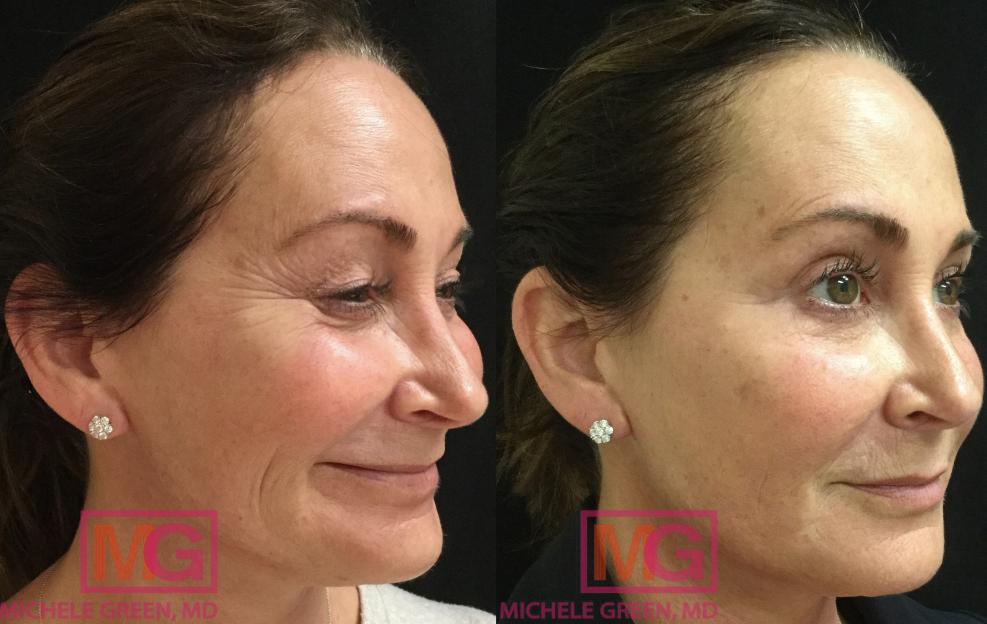
Can Botox be preventative?
While Botox was initially used to treat existing dynamic wrinkles, it is now often used as a preventive measure against the formation of fine lines and wrinkles. Dynamic wrinkles form when the skin folds during muscle contractions. If the muscles are prevented from contracting, the skin remains smooth, which helps stop wrinkles from developing. Preventive treatments usually involve a lower dose of Botox compared to regular treatments. The use of preventive Botox has become more popular, in part because celebrities and social media influencers openly share its benefits. Botox is approved for patients aged 18 and older, and many in their mid-20s choose preventive or “baby” Botox to halt fine lines from forming early. If you want to prevent wrinkles before they appear, schedule a consultation with Dr. Michele Green in NYC.
Does Botox hurt?
No, Botox injections are generally painless. They are done quickly with a small needle to reduce pain and discomfort. However, some patients may experience some discomfort from the needles or injections. If this occurs, a topical numbing cream can be applied to the treatment area for an hour before your Botox procedure. Ice packs are used immediately after the injections to help minimize swelling.
Is Botox toxic?
No, Botox injections are not toxic. Although Botox contains botulinum toxin, the same toxin responsible for botulism, it is a very safe treatment for facial rejuvenation. Botox has been approved by the FDA for over 20 years, confirming its safety and effectiveness through extensive clinical studies and trials. While Botox is highly safe, it is essential to have the injections administered by a skilled professional, such as board-certified dermatologist Dr. Michele Green, to ensure safe, effective, and natural-looking results.
Is Botox permanent?
Unfortunately, the effects of Botox injections are only temporary, typically lasting three to four months. Patients can maintain their results by scheduling regular “touch-up” Botox sessions with Dr. Green. The semi-permanent nature of Botox offers the benefit of greater control over appearance, allowing patients to adjust treatments to suit their evolving aesthetic goals. When you consult with board-certified dermatologist Dr. Green, she will develop a personalized Botox treatment plan tailored to help you achieve smooth, clear skin.
Can Botox be dissolved?
Unlike hyaluronic acid fillers, Botox cannot be dissolved. However, the effects of Botox are temporary, lasting only three to four months. Botox is an excellent non-invasive cosmetic treatment, providing consistently stunning, natural, youthful-looking results. Yet, when an inexperienced provider injects Botox, unwanted cosmetic outcomes and side effects can occur. Fortunately, Botox is a temporary treatment, and its effects typically wear off after three to four months. The best way to avoid unwanted effects altogether is to consult with expert injector Dr. Michele Green in NYC. Dr. Green was among the first dermatologists in NYC to offer Botox injections and has over twenty years of experience in cosmetic facial treatments to ensure you get the best Botox results.
How much does Botox cost?
The cost of Botox treatment can vary based on factors like the injector’s experience and skill, as well as the clinic’s location. Some clinics charge per number of units used, while others charge based on the treated areas. The experience of the injector also affects the treatment price. While it might be more affordable to have a nurse injector or aesthetician perform the procedure, Botox injections should always be administered by a board-certified dermatologist, such as Dr. Michele Green, to ensure safety and the best results. When you consult with Dr. Green, she will work with you to develop a personalized facial rejuvenation plan tailored to your specific needs, goals, and budget.
Do you tip for Botox?
You do not need to tip your Botox injector. Board-certified dermatologists or plastic surgeons perform Botox injections, and you should not tip them for their services.
Does insurance cover Botox?
Insurance companies may cover Botox for certain neurological conditions, such as migraines. However, for cosmetic purposes, insurance companies do not reimburse for Botox injections. The best way to determine if your Botox treatments are covered is to contact your individual health insurance provider for specific details.
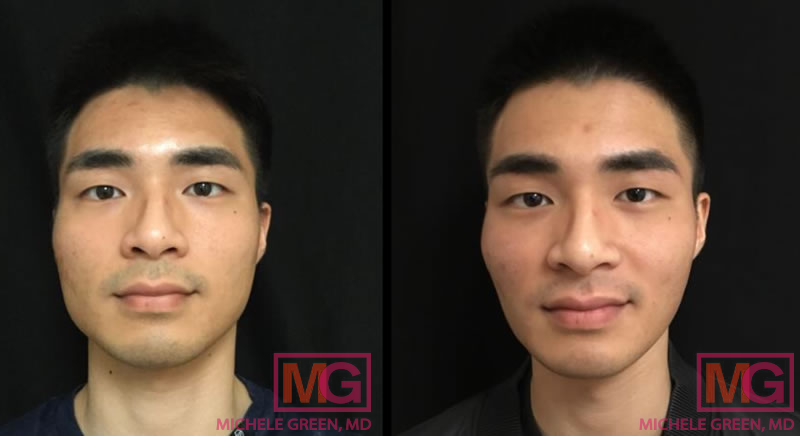
Can you exercise after Botox?
Dr. Green advises avoiding heavy exercise for 48 hours after Botox injections. Working out increases blood flow, which can worsen swelling or bruising and potentially prolong their presence. Additionally, saunas and steam rooms should be avoided for 48 hours following cosmetic injections, as this can cause swelling in the treated area.
Can you drink alcohol after Botox?
It is best to avoid drinking alcohol for one day before and after Botox treatment, as alcohol can thin the blood and increase the likelihood of bruising.
Can you shower after Botox?
Absolutely! Taking a shower after Botox won’t affect the results; however, be careful when washing your face. Avoid scrubbing the treated areas with excessive pressure, as this can cause Botox to migrate. Additionally, patients should maintain an upright head position for four hours after the procedure.
Can you fly after Botox?
After getting Botox, it is safe to fly. The negative cabin pressure at high altitudes will not impact the Botox.
Can I get Botox while pregnant?
No, Botox is not FDA-approved for use in pregnant patients. Botox injections are classified as Pregnancy Category C, meaning there are no adequate and well-controlled studies confirming their safety for the fetus. Therefore, Botox should not be given to pregnant women due to potential risks to the fetus. Additionally, Botox injections should not be administered to women who are breastfeeding, as no studies have established that Botox is safe during breastfeeding.
How long does Botox last in the forehead?
Botox typically lasts three to four months on the forehead. Its duration depends on the patient’s metabolism; some report that their Botox lasts up to six months. Many patients opt for regular Botox treatments to maintain optimal cosmetic results.
How long does Botox last in the lips?
A Botox lip flip is a cosmetic procedure that “freezes” the muscles of the upper lip, preventing them from pulling down on the upper lip. The upper lip can then “flip” and curl outward, creating the appearance of a subtle increase in volume in the upper lip for those who do not want dermal fillers. A Botox lip flip can last for three to four months.
How long does Botox last in the masseter?
Botox can be injected into the masseter muscles to relieve TMJ pain and reduce facial fullness. It temporarily paralyzes the muscles, preventing contraction and gradually relaxing them, which helps ease jaw discomfort. Patients can see results lasting between three and four months. With regular maintenance, the strength of the masseter muscles diminishes, allowing patients to extend the interval between Botox treatments up to six months. When you consult with Dr. Green in her private dermatology office, she will collaborate with you to develop a personalized treatment plan designed to deliver consistent results.
What is Botox treatment for hair?
Hair Botox treatment differs from Botox injections used for cosmetic or medical reasons. It is a deep conditioning treatment that includes ingredients like antioxidants, vitamin B5, vitamin E, and a collagen complex. It helps repair damaged hair caused by heat and stress, leaving it hydrated and smoother. The name “Hair Botox” is used because it produces stunning, refreshed results similar to the effects of injectable Botox on the face.
Is Botox a dermal filler?
No, Botox is not a dermal filler. Dermal fillers refer to injectable cosmetic treatments like Juvederm, Restylane, Belotero, and Sculptra, which add volume, define the face, and reduce the appearance of acne scars. They can also smooth out lines and creases caused by age-related volume loss. Botox is a neuromodulator that blocks nerve signals to muscles, preventing contractions and the formation of dynamic fine lines and wrinkles from facial expressions. Often, dermal fillers and Botox are combined in treatment plans to achieve full-face rejuvenation and natural-looking, stunning results. When you consult with Dr. Green in NYC, she will evaluate your facial anatomy and skin concerns to develop a personalized treatment plan that leaves you with smooth, radiant, youthful-looking skin that lasts.
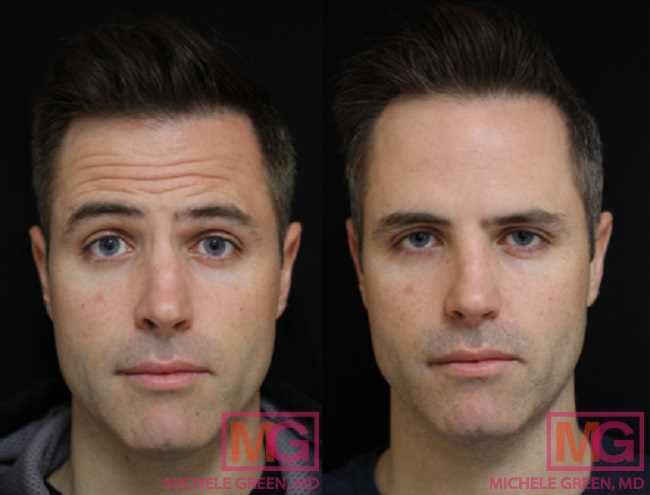
25-34 year old male, Botox before and after
Do aestheticians perform Botox injections?
Yes, aestheticians can administer Botox injections in medical spas in some states. Botox has become a very popular cosmetic treatment since its FDA approval for wrinkle treatment in 2002. Due to its popularity and high demand, an increasing number of medical spas are offering Botox injections. While aestheticians might provide cheaper Botox treatments, the risk of unwanted and serious side effects rises significantly when an unqualified or inexperienced injector performs the procedure. It’s best to have your Botox injections performed by a board-certified dermatologist in a medical setting to ensure the procedure is done correctly with the proper injection technique. Dr. Green in New York City is a globally recognized, board-certified cosmetic dermatologist with over 25 years of experience delivering top-quality Botox treatments to patients worldwide.
How do I get started with Botox injections today?
If you’re considering a non-surgical cosmetic treatment to reduce fine lines and wrinkles on your face, Botox might be the best choice. Botox works by ‘freezing’ and relaxing facial muscles, which decreases muscle contractions and prevents the formation of dynamic wrinkles and lines. Since receiving FDA approval for cosmetic rejuvenation in 2002, Botox has become one of the most popular non-invasive treatments worldwide due to its simplicity, minimal downtime, and consistently impressive results. When you get Botox injections from expert injector Dr. Green in NYC, you can expect a smooth, youthful, and beautiful complexion that lasts.
Dr. Michele Green is a highly respected, board-certified dermatologist with over 25 years of experience. She specializes in providing some of the world’s most discerning clients with top non-invasive cosmetic treatments, including Botox injections. Dr. Green employs a holistic, less-is-more approach to facial rejuvenation, customizing each patient’s treatment plan to best meet their needs and achieve the best results. She is consistently recognized as one of NYC’s top dermatologists by Super Doctors, New York Magazine, and Castle Connolly for her dedication and expertise. To find out if Botox might be right for you, contact our NYC office today or call 212-535-3088 to learn more about whether Botox or a combination of Botox injections with dermal fillers such as Juvederm, Sculptra or Restylane, along with our extensive cosmetic treatments may be the best choice for you.
Related Topics
- Botox Treatments for Masseter Muscle
- Botox for lip lifts and lip augmentation
- Best Botox Options for Male Patients
- Compare Botox & Dysport
- First time getting Botox? Read common questions.
- Botox for Brow Lifts & Glabella (Forehead)
- Botox for Palmar Hyperhidrosis (Sweaty Palms)
- Botox for Migraines
- What is Micro-Botox, Find out More
- Botox for Jaw Clenching
 212-535-3088
212-535-3088 